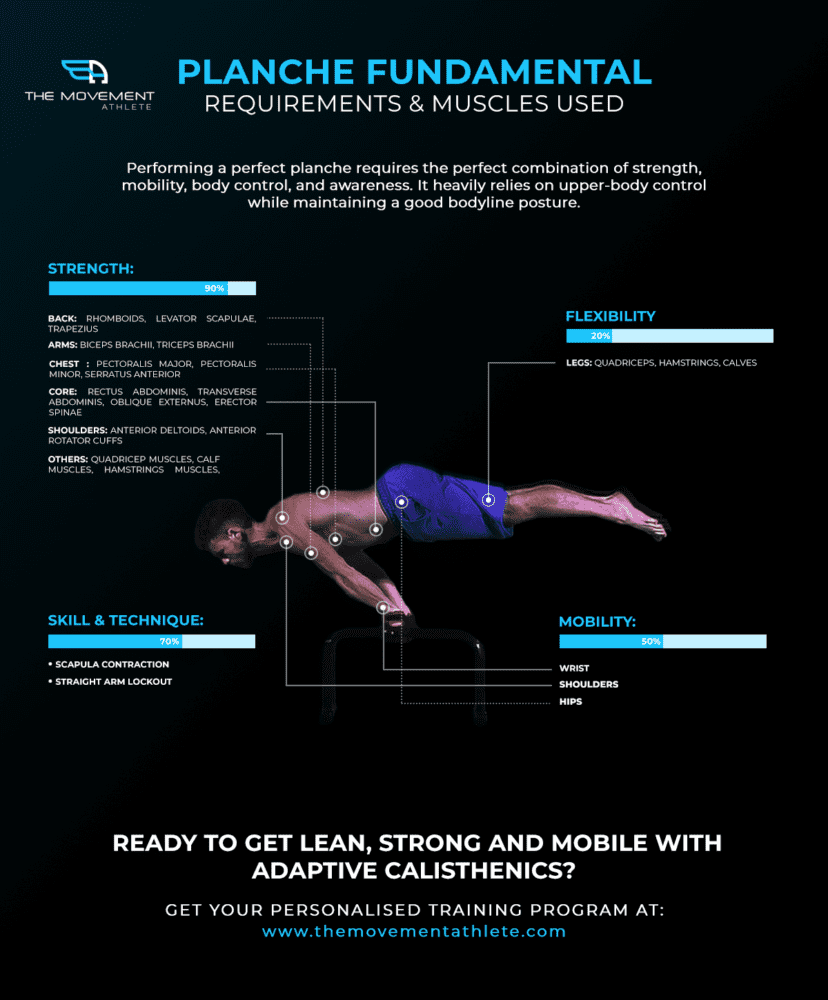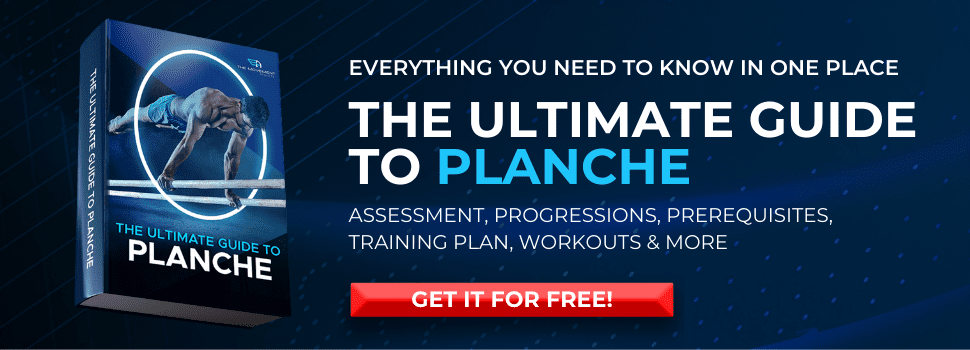Join the tribe of Movement & Calisthenics Athletes – people just like you that are working with their own body weight to get strength, lose fat build muscle, recover from injuries and live their best lives!
For us mere mortals, planche looks like an impossible task that requires removal of our lower extremities in order to perform the skill. That’s really not the case.
Let me tell you that a learning planche is POSSIBLE for everyone.
But this possibility requires smart allocation of time and effort. Our time and our bodies are valuable assets that we need to take care of. That being said, we can’t really just jump immediately to planche.
We’re going to talk about the requirements for starting the planche journey and for learning the main skill. Knowing the muscles activated when performing the skill must also be understood in order to learn planche faster and more efficiently.
📌 Factors affecting your planche
journey
Let’s first take a glimpse of what you need to consider first when learning the planche so you’ll get a more realistic goal and get super frustrated during your journey.
👉 Our Bodies Matter
Since calisthenics is the use of our bodies as resistance, height, weight, and body fat percentage highly matter, those factors naturally affect the difficulty of learning planche. Especially that this is a leverage skill that puts your body in a highly mechanically disadvantageous position. Physics, gravity, and our biomechanics are against us so we must put in the extra work to achieve our goal.
But since our bodies are each different in many ways, we also need to consider our differences when learning the planche:
- Shorter people will progress faster than taller people
- Lighter people will progress faster than heavier people
- Leaner people will progress faster than people with higher body fat percentage
- People with smaller legs will progress faster than people with bigger legs
Although we cannot do anything about our height, our weight and body composition can be adjusted through proper nutrition. If you really want to achieve planche, you must also do the work in the kitchen.
You can learn planche faster if you don’t train your legs but who wants chicken legs? Even if your goal is planche, our main goal is still to have a strong, healthy, and complete body. Don’t skip leg day!
👉 Starting Training Experience
Take into account your starting point when learning planche. Just like in a race, a person starting in the middle of the track will most likely complete it faster than someone who will start at the back end of the track.
In the planche journey, having a higher base of strength and calisthenics foundation will give an edge to learn the skill much faster compared to someone who’s just starting out to learn a push-up.
👉 Age affects us all
As much as we want to say that age doesn’t matter, it matters. Younger people tend to progress and learn much faster. They also have fewer responsibilities and more time to train compared to someone in their 30’s with work, family, and personal life that they need to balance. These commitments are inevitable and cannot be brushed off just to learn planche. Which is why younger individuals might want to pursue planche harder.
Individuals above 50 experience the inevitable muscle loss that time places upon us. Expect slower progress at this point but planche still open to the table.
👉 Rest & Stress
Like any time of training or goals, proper rest and stress management play an important role for growth and development. There’s no sense in training hard and eating properly if you don’t take high-quality rest.
Always keep in mind that we get stronger during our rest, not during the exercise. If you want to learn planche much faster, manage your stress levels in and outside your training and get some high-quality rest
👉 Training Consistency
Planche is a skill. Like any other skill, you need to train it consistently with much focus. You won’t learn it by training it once a week. Training frequency and focus play a huge role in skill development.
Planche is a highly complex skill that demands complete attention if you want to learn it efficiently. As you will read later on, the requirements are high so you really need to put much focus on the process in order to achieve it.
👉 Injuries
Since calisthenics is the use of our bodies as resistance, height, weight, and body fat percentage highly matter, those factors naturally affect the difficulty of learning planche. Especially that this is a leverage skill that puts your body in a highly mechanically disadvantageous position. Physics, gravity, and our biomechanics are against us so we must put in the extra work to achieve our goal.
Don’t get discouraged!
With all the factors being said, we have discussed these not to discourage but to provide you an idea of what the planche journey would look like so you can set your goals realistically. This will keep your motivation and drive high as your expectations will be much closer to what would really happen especially with our progress not being linear.
💪 What are the muscles used for
Planche?
Let’s take a closer look at the muscles used when performing a planche so we can further understand the movement. A better understanding of the mechanics helps us learn the skill much faster.
Here are the muscles in action:

👊 What are the requirements to perform
the skill?
Requirements & Muscles used
☑️ Strength:
Established general strength and planche specific-strength is required to perform this skill. Obviously, the skill is a display of a tremendous amount of upper-body strength, specifically; amazing shoulder strength, straight arm strength, and powerful wrists.
While a strong core is also needed to hold the position, the core plays a lesser role compared to the upper-body strength. As long as you have adequate core strength such as being able to hold a powerful hollow body, you are already good to go.
Planche is a full-body move. You have to activate your full body in order to hold the move, but of course, there are still muscles that play a more important role when performing the skill.
Here are the main muscles used in planche:
Chest: Pectoralis Major, Pectoralis Minor, Serratus Anterior
Shoulders: Anterior Deltoids, Anterior Rotator Cuffs
Arms: Biceps Brachii, Triceps Brachii, Wrist muscles, Wrist muscles
Back: Rhomboids, Levator Scapulae, Trapezius
Core: Rectus abdominis, Transverse Abdominis, Obliquus Externus, Erector Spinae
Others: Quadricep muscles, Calf muscles, Hamstrings muscles, Neck Muscles, Hip muscles
☑️ Mobility:
Mobility is a common area where people lack when performing the skill. It is needed to maximize strength and performance for planche.
Wrists
Your wrists are forced to work extra hard when performing a planche, especially when done on the floor. Each progression of the planche requires wrist mobility and the demand increases even more as you move closer to the full planche.
There are different hand placement for planche which means there are also different wrist movements for the move. The important thing is having an overall strong and mobile wrist for any direction and using a hand placement that’s comfortable for you. Usually, an outward 45-degree angle works best for most people.
Shoulders
Your wrists work together with your shoulders to achieve the balanced position of the planche. The very awkward forward lean puts massive stress on your anterior deltoids while holding a protracted scapula. Complete shoulder mobility, as well as back mobility, gives you a great advantage to maximize strength output when performing the planche.
Hips & Legs
Sounds weird since planche is an upper body strength skill work, but remember that you have to fully extend your legs to perform the full planche. You can’t do that with weak immobile hips and legs. Good things we’ll work on progressions to build the necessary mobility to hold legs in position for the planche. Without proper hip and leg mobility, you can only reach an advanced tuck planche.
☑️ Skill & Technique:
This move isn’t only about strength and mobility, it requires proper technique and cueing to execute in perfect form.
Scapula protraction
A solid scapula protraction is a necessary skill to master planche. Not only it is mandatory for the proper form, but it also allows proper chest, shoulder, and back activation when performing the movement. You must learn how to perform the protract the scapula while maintaining the proper body posture.
Straight bodyline
Speaking of posture, maintaining a strong and straight bodyline is also needed. It’s a strength aspect in which core plays an important role but there’s also a skill in it. You can have a strong core without knowing the right feeling of having a complete straight bodyline.
To achieve the proper bodyline, the core should be strong enough to maintain a posterior pelvic tilt (PPT) in different positions. This skill lets you be aware of proper posture even when you are moving into a planche.
Full-body Activation
Calisthenics requires full-body activation even with the calisthenics “isolation” exercises. Adding the air quotes is a must since there are no real isolation exercises in calisthenics. All exercises demand multiple muscle groups to acquire movement which is highly advantageous.
In terms of the planche, learning how to fully activate each and every fiber of your muscles will produce maximum output for planche performance. Without the full activation, expect your efforts to be substandard when training the skill.
Straight-arm lockout
Straight-arm lockout is both a skill and strength component, just like the whole planche. When performing the planche, it’s no longer the actual planche even if you slightly bend your elbows. A bend on the arms will provide an advantage. That’s cheating!
Proper arm cueing regardless of hand placement teaches the correct technique to hold the complete straight-arm lockout.
Keep in mind that when practicing this skill, take things slowly as this is not a common position for the average person to hold.
☑️ Endurance:
Planche looks like a skill that demands superhuman strength. To tell you the truth, it does not. Arching of the lower back when performing planche is mistakenly identified as deficiencies with core strength. In actuality, the arching of the lower back is compensation due to lack of forward lean when performing the planche.
As long as you have good enough hip mobility and core strength, your core shouldn’t be an issue. A good indicator is if you have mastered the bodyline fundamental.
Have good core endurance will allow you to train planche throughout the week as the core will always be activated in each exercise.
✊ Requirements to start training Planche
To start your planche journey, you must first master two fundamentals: Bodyline fundamentals and push-ups
- Mastering the bodyline allows you to perform good posture for the planche. It also teaches the proper awareness and activation of the core.
- Even though planche is a static exercise that demands straight-arm strength, it is a pushing exercise. This is when push-up comes to play. Push-ups help develop a good base of pushing strength. The bent arm nature of the exercise still transfers to the straight-arm requirement of planche. Master your push-ups and you’ll make faster progress for planche.
BODYLINE FUNDAMENTAL
Pseudo plank hold
Elbow plank on knees hold
Elbow plank
Arm plank hold
Running man
Elbow plank pulses
Rocking hips elbow plank
Plank pulses
Single elbow plank hold
Unstable surface plank
One arm plank
